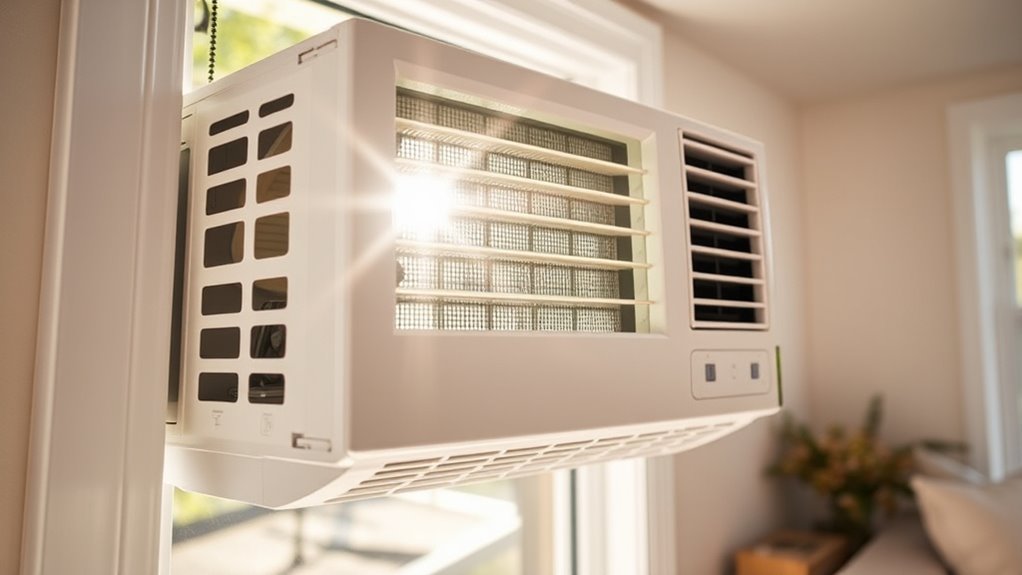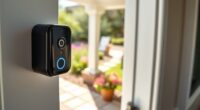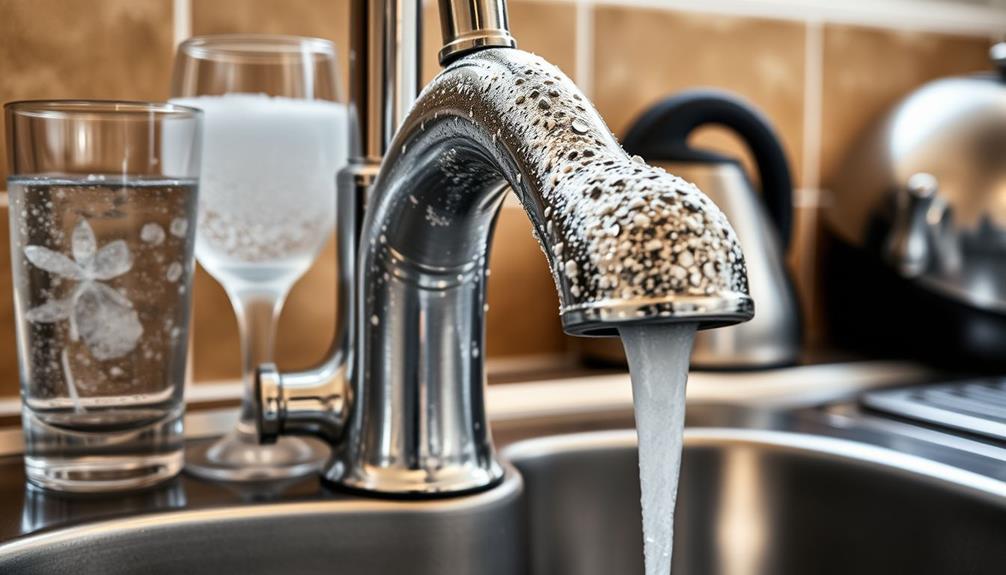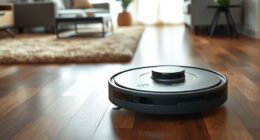Window heat pumps use refrigerant cycles to heat and cool your space through a simple window-mounted unit. They switch between modes with a reversing valve, providing efficient climate control without ductwork or manual swaps. Ideal for small spaces or retrofit projects, they save energy and lower bills, especially in moderate climates. Frost and cold weather can limit their effectiveness, but they shine where quick installation and versatility matter most. Keep exploring to find out more.
Key Takeaways
- Window heat pumps transfer heat between indoor and outdoor environments using refrigerant, with reversible operation for heating or cooling.
- They are ideal for small spaces, retrofitting existing rooms without extensive modifications, and provide energy-efficient climate control.
- Suitable for moderate climates with outdoor temperatures above 25°F, offering reliable performance in mild to warm conditions.
- Easy to install within a day, fitting into standard window frames, making them ideal for apartments, small homes, and multi-family buildings.
- They offer seamless seasonal switching, high energy savings, and environmental benefits, especially when replacing traditional electric or fossil fuel systems.
The Basic Mechanics Behind Window Heat Pumps
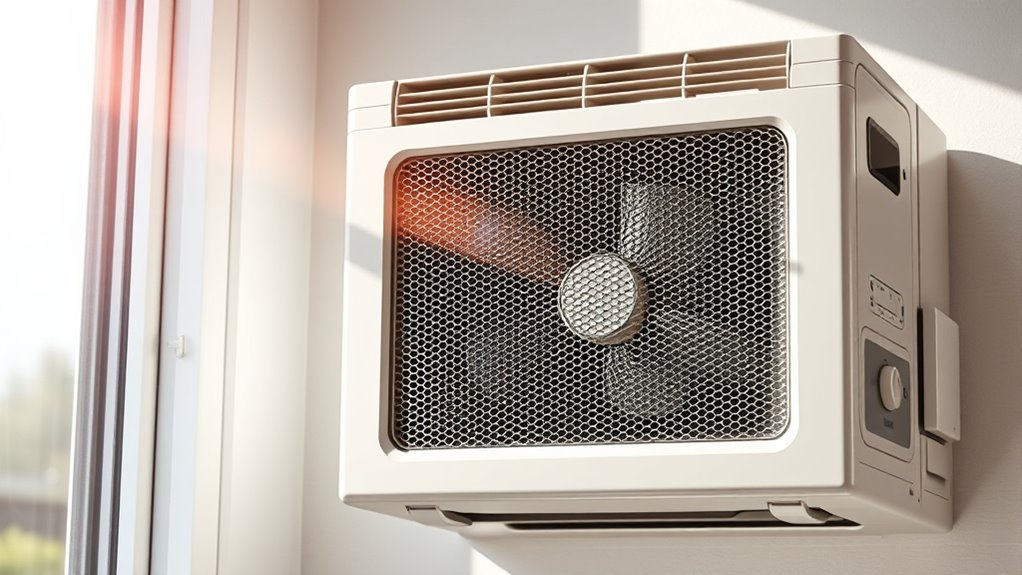
Window heat pumps operate by using a refrigerant to transfer heat between indoor and outdoor environments. The refrigerant circulates through coils—such as the evaporator, condenser, compressor, and expansion valve—to move heat efficiently. In cooling mode, it absorbs heat from inside, evaporates, and then compresses into a high-pressure gas. This high-pressure gas releases heat outside via the condenser. When heating, the cycle reverses, pulling heat from outside air to warm your space. A reversing valve switches the refrigerant flow, allowing seamless changeover between modes. The compressor increases refrigerant pressure and temperature, boosting heat transfer. Fans blow air over coils, ensuring effective heat exchange. This cycle is controlled by thermostats and sensors to maintain consistent indoor temperatures. Additionally, some models incorporate advanced controls to optimize energy efficiency and performance. This compact cycle enables your window heat pump to provide reliable comfort year-round, no matter the season.
Furthermore, refrigerant properties play a crucial role in the efficiency and environmental impact of heat pumps, making the selection of the right refrigerant essential for optimal performance.
Comparing Energy Efficiency and Cost Savings
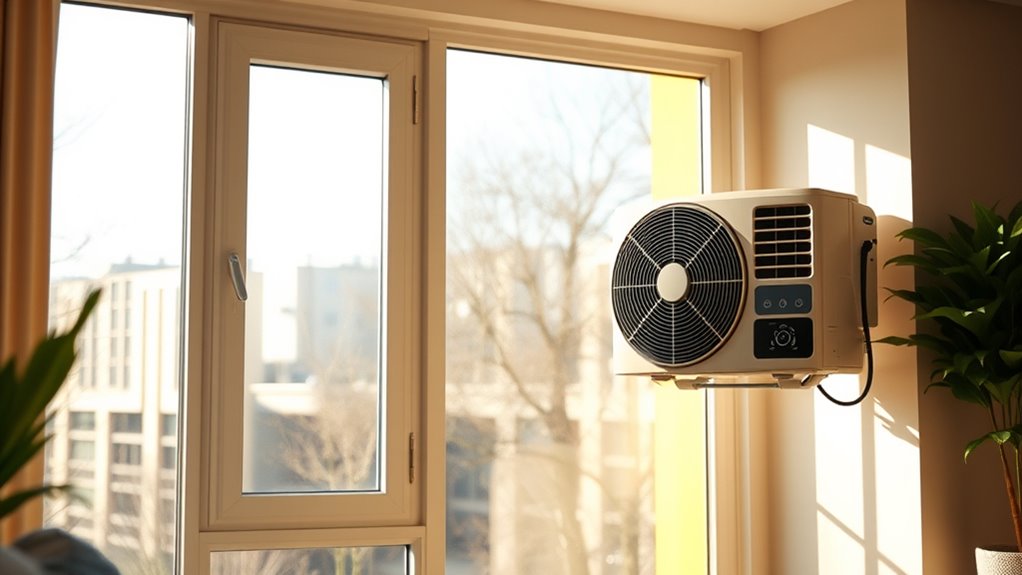
Are you wondering how energy-efficient window heat pumps really are and what that means for your wallet? These units use about 10% less energy than comparable models, thanks to their high efficiency ratings like EERs between 8.5 and 10, and HSPFs of 9 or higher. When you choose ENERGY STAR certified models, you can save around 10% on energy costs. Plus, their zone-specific heating and cooling options help you target only occupied rooms, further reducing expenses. You might also qualify for tax credits up to $2,000, making installation more affordable. Keep in mind, their efficiency surpasses standalone electric heaters and avoids duct losses common in central systems. Overall, better efficiency means lower bills and a smaller environmental footprint. Higher HSPF ratings indicate better heating efficiency, helping you save even more over the lifespan of your unit.
Considerations for Proper Installation and Design
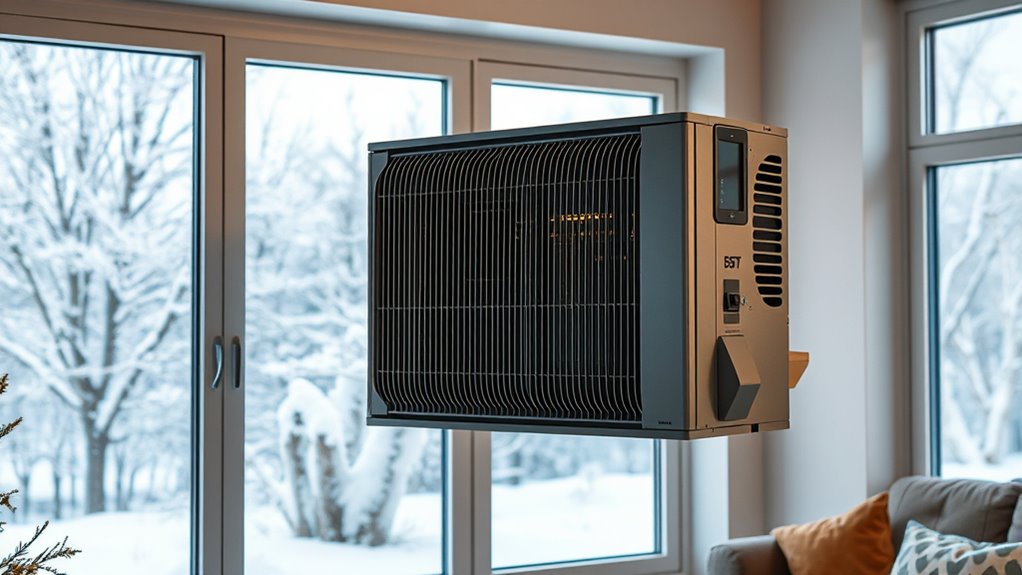
Proper installation and design are essential to maximize the efficiency and safety of your window heat pump. Verify the window width is between 25″ and 36″ for a proper fit, with a vertical clearance of at least 14.5″ to accommodate the unit when the window is open. The window frame and sill must be sturdy enough to support the weight, preventing damage or safety issues. Slightly tilting the unit downward by about 3° helps with proper condensate drainage. Seal all gaps at the top and sides with foam or putty to prevent air leaks and improve energy efficiency. Secure side panels and brackets firmly, verifying leveling with a level tool. Use a grounded electrical outlet and consider dedicated circuits to avoid overloads, ensuring safe, reliable operation. Additionally, understanding the role of contrast ratio can help you optimize your setup for better image quality and viewing comfort. Ensuring proper airflow around the unit also contributes significantly to its overall performance and energy efficiency.
Ideal Settings and Situations for Use
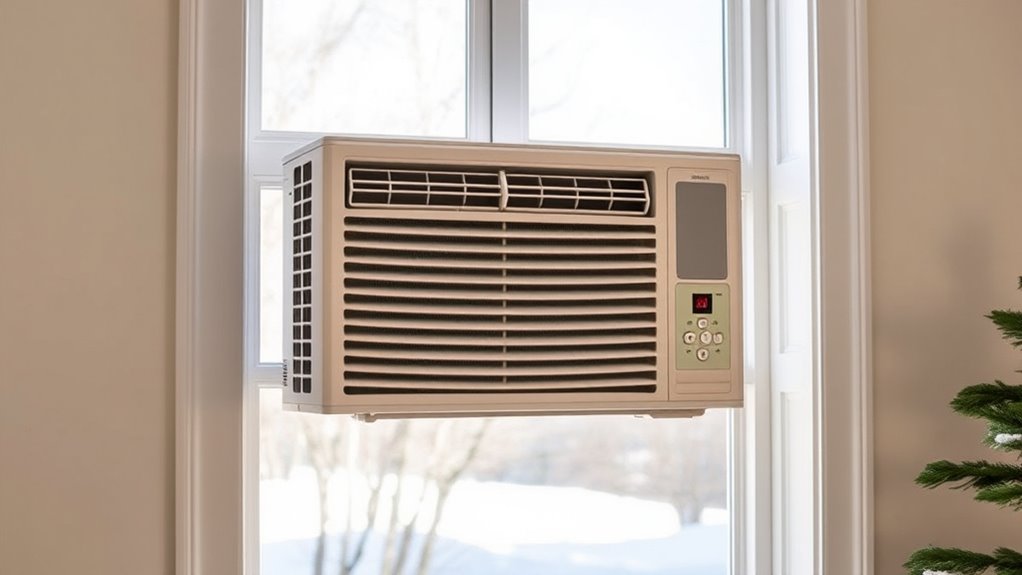
If you’re looking to improve comfort in a small space, window heat pumps can be a great choice. They work best in moderate climates where outdoor temperatures stay above 25°F, providing efficient heating and cooling. These units are especially useful as retrofit solutions in existing rooms without central HVAC, offering a simple way to add heating to your home. Additionally, understanding the trust issues that can arise in relationships might help you better evaluate the reliability of your heating system and ensure consistent performance. Regular maintenance and proper installation can also extend the lifespan and efficiency of your heat pump.
Small Space Comfort
Small space comfort with window heat pumps is ideal when you need efficient temperature control in compact areas like single rooms, small apartments, or modest homes. These units are perfect for maintaining a cozy environment without the need for complex installations. They’re portable, affordable, and easy to operate, making them suitable for various setups. Their zonal control allows you to heat or cool specific spaces, reducing energy waste. Plus, their low power consumption and ENERGY STAR ratings help save on energy bills. Whether you’re renting or managing an older home, these heat pumps adapt well to your needs. They’re quiet, environmentally friendly, and deliver reliable comfort where space is limited. Comfort Solutions for Sofa Beds are also compatible, providing additional support and convenience. Incorporating automation technologies can further optimize energy use and comfort in small living areas.
Moderate Climate Use
Window heat pumps excel in moderate climates because they deliver efficient heating and cooling without the need for extensive modifications to your home. They transfer heat rather than generate it, which cuts down energy use and lowers costs. Designed for small to medium-sized spaces, they work best when outdoor temperatures stay above 40°F (around -1°C), making them ideal for regions with mild winters and summers. These units are quick to install, often taking just a few minutes, and don’t require ductwork, saving space and effort. Certified Energy Star models ensure you get reliable efficiency, helping you save on energy bills. Their effectiveness is also enhanced when paired with proper insulation, which maintains indoor temperatures more effectively. Additionally, understanding Hyundai Tuning concepts can inspire innovative ways to optimize your home climate control systems. Whether in urban apartments, small homes, or rural settings, window heat pumps provide effective, versatile climate control suited for moderate zones.
Retrofit Heating Solutions
Retrofit heating solutions are particularly effective in settings where space limitations or existing infrastructure make traditional central systems impractical. They excel in multi-family housing, public, and affordable housing where quick, minimally disruptive installation is essential. These solutions are ideal for older buildings lacking central HVAC, avoiding costly ductwork or boiler upgrades. They work well in apartments or individual rooms, providing spot heating that avoids wasting energy on unoccupied spaces. Additionally, they can replace inefficient window units, offering both heating and cooling in one device. AI security advancements have also contributed to developing smarter, safer retrofit systems. Moreover, their compatibility with energy-efficient technology helps optimize overall energy consumption and reduce operational costs.
- No need for electrical panel upgrades or specialized wiring
- Minimal installation time, often completed in under a day
- Compact design fits various window sizes
- Suitable for cold climates without backup heating
- Enhances energy efficiency and reduces costs
Benefits Over Traditional Cooling and Heating Devices
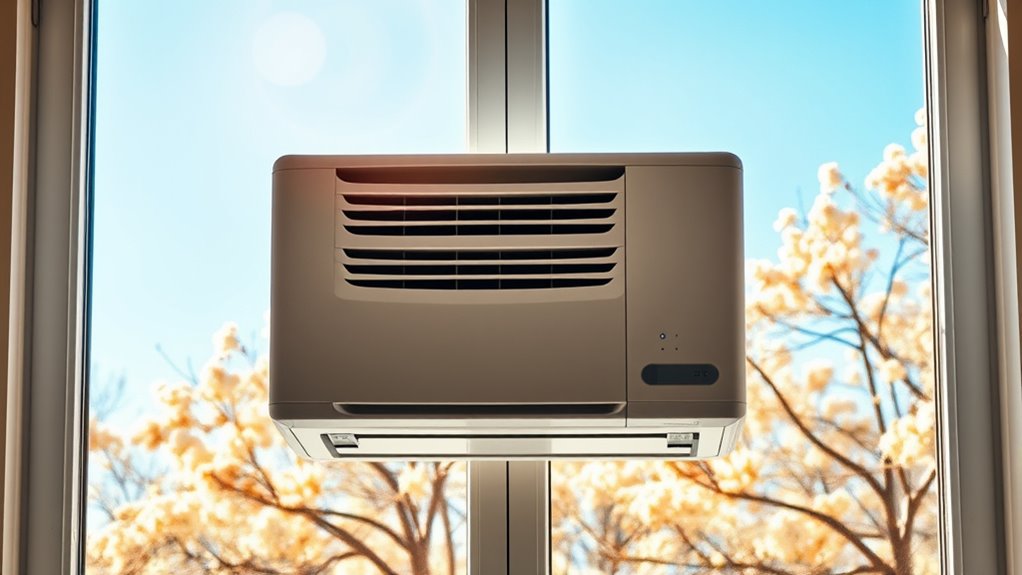
Window heat pumps offer the convenience of both heating and cooling in one system, saving you space and simplifying maintenance. They are more energy-efficient than traditional devices, reducing your utility bills and environmental impact. Plus, their permanent installation minimizes disruption and avoids the hassle of seasonal setup and removal. Additionally, selecting high-quality sound effects libraries can enhance the performance and reliability of your heating and cooling systems. As technology advances, integrating home security systems can further improve safety and control over your living environment.
Dual Functionality Advantage
Combining heating and cooling in a single unit offers a significant advantage over traditional devices by streamlining your climate control needs. With a window heat pump, you get seamless seasonal shifts without switching appliances. You can easily reverse the refrigerant flow to switch between heating and cooling modes, eliminating the hassle of manual swaps or multiple devices. This dual functionality saves space, reduces clutter, and simplifies maintenance. Plus, it’s cost-effective—saving you money upfront and on operating expenses. The compact design fits standard windows, freeing up indoor and floor space. Incorporating space-saving solutions like window heat pumps aligns with effective home organization and decluttering strategies, which are essential components of comprehensive cybersecurity for modern smart homes.
Higher Energy Efficiency
The dual functionality of window heat pumps not only simplifies your climate control but also delivers impressive energy savings compared to traditional heating and cooling devices. They use up to 87% less energy than fossil-fuel-based steam systems, slashing your energy bills markedly—by 50% or more. Data from NYCHA shows they consume less energy per square foot, making them more efficient for large-scale use. During summer, they reduce peak cooling energy, thanks to high efficiency. Over time, these units maintain performance, providing consistent savings across multiple seasons. Their lower total long-term costs—around $14,500 over 24 years—outperform more expensive alternatives like central or mini-split systems. This efficiency makes window heat pumps an economical, eco-friendly choice for your home or building. Additionally, their advanced technology, including smart systems, can enhance overall energy management, and further improve efficiency.
Furthermore, understanding the Relationships – Personality Test can help homeowners better communicate with service providers or troubleshoot issues more effectively.
Reduced Installation Disruption
Installing heat pumps can be quick and straightforward, often taking just a few hours rather than several days. This means less disruption for you and your household. Unlike traditional systems, window heat pumps don’t require extensive modifications like ductwork or large wall openings. They fit directly into existing window frames, eliminating the need for outdoor condenser placement and minimizing site prep. You can install them room-by-room, allowing flexibility and avoiding major renovations. This simple process reduces noise, dust, and inconvenience during installation. Plus, it avoids drywall repairs and keeps your space usable throughout the process. Overall, window heat pumps provide a hassle-free setup that minimizes disturbance and keeps your home operational during installation. Resources and Tools can help you find the right model and professional installation services for your needs. Additionally, understanding creative practice can help homeowners approach their renovation with a problem-solving mindset, making the process even smoother.
Limitations and Challenges in Cold Climates
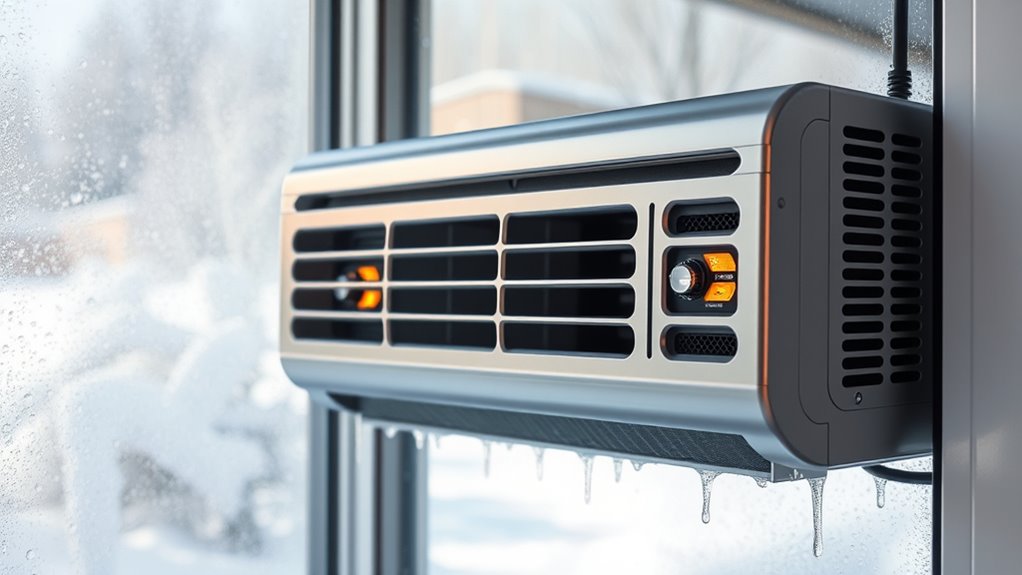
Have you ever wondered why window heat pumps struggle in cold climates? At temperatures below freezing, their efficiency drops sharply. Most units struggle below 25°F (-4°C), needing backup heat sources in harsher cold. The refrigeration cycle becomes less effective because the working fluids can’t absorb or release heat efficiently at low temps. Advanced models with special refrigerants can operate down to 5°F (-15°C), but frost and ice buildup pose significant challenges. Frost blocks heat transfer, reducing performance and risking mechanical strain if not properly managed. Defrost cycles are necessary but temporarily reduce heating output and increase energy use. Additionally, limited outdoor airflow, smaller window sizes, and noise during defrosting further hinder their effectiveness in cold weather.
Frequently Asked Questions
How Long Does a Typical Window Heat Pump Last?
A typical window heat pump lasts about 10 to 15 years if you keep up with regular maintenance. With proper care and quality units, some can reach 20 or even 30 years. Poor maintenance, environmental factors, or improper installation can shorten their lifespan. To maximize longevity, clean filters regularly, schedule professional tune-ups, and address issues promptly. Replacing around 15 years prevents unexpected breakdowns and maintains your comfort.
Can I Install a Window Heat Pump Myself?
Yes, you can install a window heat pump yourself if you’re comfortable with basic tools and follow instructions carefully. Start by measuring, matching, and mounting the brackets securely, then snugly fit the unit into the window frame. Seal gaps with weatherstripping, plug into a grounded outlet, and wait to power on. Be cautious with heavy lifting, and if you’re unsure about electrical work, consider seeking professional support for safety and success.
Do Window Heat Pumps Require Regular Maintenance?
Yes, window heat pumps need regular maintenance to stay efficient. You should clean filters every two weeks and coils every two months to prevent dust buildup. Keep the outdoor unit clear of debris, snow, and vegetation, and check for proper airflow. Additionally, schedule an annual professional inspection to guarantee refrigerant levels and system components are in good shape. Regular maintenance helps your heat pump run smoothly and extends its lifespan.
Are There Noise Concerns With Window Heat Pumps?
Imagine a gentle hum like a soft breeze drifting through your window—that’s how noise from window heat pumps typically feels. They operate within 50 to 60 decibels, similar to a conversation, so it’s usually not disruptive. However, if installed near sleeping areas or reflective surfaces, that hum can grow louder, potentially disturbing your rest. Selecting quieter models and proper installation can help keep that breeze calming rather than bothersome.
How Do Weather Conditions Affect Heat Pump Performance?
Weather conditions directly impact your heat pump’s performance. When outdoor temperatures drop below freezing, it becomes harder for your system to extract heat, reducing efficiency and increasing energy use. High humidity makes cooling less effective because your system works harder to dehumidify. Extreme cold or humid weather can cause frost buildup or other issues, requiring extra maintenance or auxiliary heating to keep your indoor climate comfortable and your system running smoothly.
Conclusion
Window heat pumps are like versatile tools in your home’s climate control toolkit, offering energy-efficient heating and cooling. When installed correctly, they can save you money and keep your space comfortable year-round. However, just like a delicate plant needs the right environment, they perform best in moderate climates. With proper care, these units can be a reliable, all-in-one solution—making your home feel just right, no matter the weather outside.
